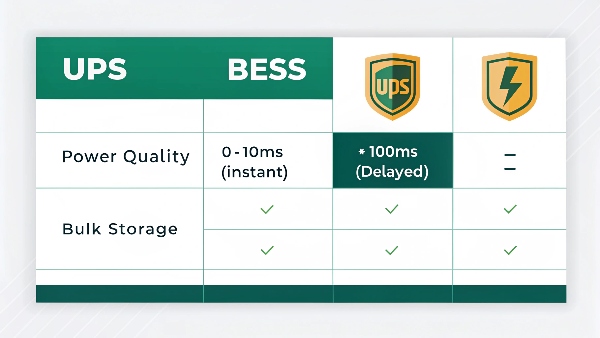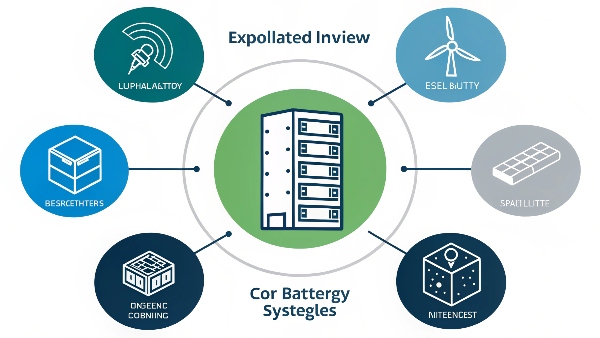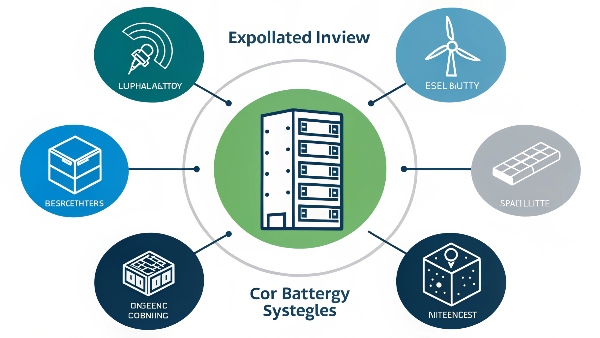You hear about BESS for solar and UPS for servers. They both use batteries, so are they interchangeable? Choosing the wrong one can leave your critical systems vulnerable and unprotected.
A UPS provides instant, high-quality power to prevent interruptions. A BESS (Battery Energy Storage System) stores large amounts of energy for longer-term use. A UPS is for uninterruptible power; a BESS is for energy shifting.

Transition Paragraph:
In my 10 years at Daopulse, I’ve seen this confusion cost businesses a lot of money. The most important insight I share with procurement managers is this: a UPS has more functions than a BESS. A UPS actively cleans and regulates power, a job a BESS is not designed to do. Understanding this functional difference is the key to protecting your critical infrastructure. It’s the difference between simple backup and true power security.
What's the real difference between a UPS and a BESS?
You need to protect your data center, but solar battery systems (BESS) look tempting. Can they do the job? A mistake here could mean catastrophic data loss during a tiny power flicker.
The main difference is speed and power quality. A UPS offers millisecond switchover and a pure sine wave output for sensitive electronics. A BESS has a slower transfer time and is built for bulk energy storage.

Dive deeper Paragraph:
As an OEM/ODM manufacturer, we engineer UPS systems for one primary goal: absolute reliability for critical loads. A BESS is engineered for a different goal: bulk energy management. This leads to fundamental differences in their design and function. A true Online UPS, for example, is always active. It continuously regenerates a perfect power signal, completely isolating your equipment from grid problems. A UPS also includes built-in surge protection and power filtering. It's an all-in-one power protection device. A BESS, on the other hand, is designed to store large amounts of energy from solar panels or the grid when electricity is cheap. Its job is to discharge this energy later to save money or provide power for hours. Its transfer time can be seconds, which is an eternity for a server that would reboot instantly.
UPS vs. BESS: A Functional Breakdown
| Feature | Uninterruptible Power Supply (UPS) | Battery Energy Storage System (BESS) |
|---|---|---|
| Primary Function | Power Quality & Instant Backup | Bulk Energy Storage & Time-Shifting |
| Transfer Time | 0-10 Milliseconds | Hundreds of Milliseconds to several Seconds |
| Power Quality | High (Pure Sine Wave output) | Varies, often not as clean as a UPS |
| Core Components | Rectifier, Inverter, Battery, Surge & Filter Circuits | Battery, BMS, Inverter, Control Software |
| Typical Use Case | Data Centers, Hospitals, Banks (Critical Loads) | Residential Solar, Grid Stabilization (Bulk Loads) |
For a System Integrator, choosing a BESS to protect a server is a critical error. You need a UPS for the job.
So, can a BESS ever replace a UPS?
You're looking to consolidate systems and save money. Can your large BESS also protect your critical servers? Relying on it might be a risk you can't afford to take.
No, a BESS generally cannot replace a UPS for critical loads. The transfer time of a BESS is too slow, which would cause servers to reboot. A UPS is required to bridge that crucial gap.

Dive deeper Paragraph:
A BESS cannot replace a UPS, but they can work together in a very powerful way. Think of it like this: a BESS is a large water tank for a building, and a UPS is the high-pressure, instantly-on fire sprinkler system. You can't use the water tank to put out a fire directly; you need the specialized delivery system of the sprinklers. In the same way, the BESS can provide long-term power, but the UPS provides the instant, clean delivery. In many large-scale projects we consult on, the ideal setup involves the BESS acting as the primary backup power source, similar to a generator. The power flows from the BESS into the UPS. The UPS then provides the final, perfect power to the critical servers. This way, you get the best of both worlds: the long runtime of the BESS and the instant protection and power quality of the UPS. For a procurement manager at a hospital, this hybrid system ensures life-support machines can run for hours, not just minutes, with zero interruption risk.
Isn't a UPS just a 'battery backup'?
People use the terms "UPS" and "battery backup" interchangeably. This common mix-up can lead you to buy a simple device when you need real, comprehensive power protection for your business.
"Battery backup" describes just one function: providing power when the main source fails. A true UPS is a system that also provides surge protection, voltage regulation, and power filtering. "UPS" implies more complete protection.

Dive deeper Paragraph:
This is a point of confusion I clear up for clients all the time. While every UPS provides battery backup, not every battery backup is a true UPS. The term "battery backup" often refers to the most basic Standby UPS models. They do one thing: switch to battery when the power cuts out. However, most business-critical damage doesn't come from full blackouts. It comes from chronic brownouts, swells, and electrical noise. A Line-interactive UPS, one of our most popular product lines, adds automatic voltage regulation. It smooths out these fluctuations without even using the battery, preserving battery life and protecting your equipment's internal power supplies. An Online UPS goes even further, completely rebuilding the power signal. So, the "battery backup" is just one of many protective functions. The full UPS system is a multi-layered defense. I've seen clients buy a cheap "battery backup" and still lose equipment to power sags. They saved a little money upfront but paid much more later.
What makes a BESS more than just a big battery?
You see a stack of batteries and think that's a BESS. But a system is more than its parts. Understanding the difference is key to specifying and procuring a reliable energy solution.
A battery is just the energy storage component. A BESS is a complete system that includes the batteries, a Battery Management System (BMS), an inverter, and control software to manage the entire process.

Dive deeper Paragraph:
A battery on its own is just a dumb box of chemical energy. A BESS is an intelligent system built around the batteries. The most critical component is the Battery Management System (BMS)1. This is the brain that protects the battery pack. It monitors the temperature and voltage of every cell, prevents overcharging or deep discharging, and balances the cells to ensure a long, safe life. This is especially vital for lithium-ion battery systems. Next is the inverter2, which is the muscle. It converts the battery's DC power into the AC power your building uses. Finally, there's the control software3. This component makes decisions. It tells the BESS when to charge from the grid, when to discharge to power your building, and how to interact with solar panels. At my company, even though we focus on UPS, we are experts in battery technology, including both lead-acid and lithium. We understand that the intelligence of the management system is what turns a simple battery into a reliable power source.
Conclusion
A UPS provides instant, clean power protection for critical devices. A BESS offers bulk energy storage for long-term use. They are different tools designed for completely different, important jobs.
-
Understanding BMS is crucial for optimizing battery performance and safety. Explore this link to learn more about its functions and benefits. ↩
-
Inverters are essential for converting DC to AC power. Discover how they function and their importance in energy systems. ↩
-
Control software is key for efficient energy management. Learn how it optimizes battery usage and integrates with renewable sources. ↩

